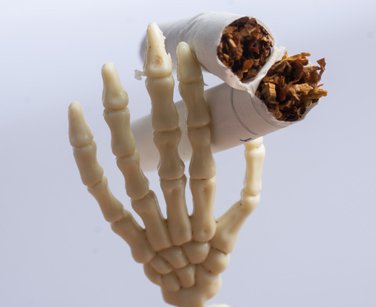
What Smoking Does To Your Bones
Let’s celebrate the Great American Smokeout today!
Heart disease, lung, throat and other cancers, chronic obstructive pulmonary disease (COPD)…we all know these risks of smoking and using tobacco products. Did you know that smoking also wreaks havoc on your bones?
According to the International Osteoporosis Association, research indicates a direct relationship between smoking and decreased bone density, as well as increased risk of experiencing a fracture; smokers are at a higher risk for osteoporosis and bone fractures. In fact, smokers are 30% to 40% more likely to break their hips than non-smokers.
Dr. Aribindi is here to explain how quitting smoking could be the best thing you do for today – and for every day of the year.
Smoking weakens bones in several ways:
- Smoking reduces the blood supply to bones, so bones don’t heal as faster or effectively.
- Nicotine – in cigarettes, vape pens or smokeless tobacco - slows the production of bone-forming cells, weakening your bones.
- Smoking decreases the absorption of calcium from the foods you eat. Calcium is necessary for bone mineralization, and with less bone mineral, smoker’s bones become fragile.
- Smoking increases your risk of developing osteoporosis or 'porous bones.” Your bones gradually thin and weaken, developing holes like in a sponge and making them susceptible to fractures.
- Smoking breaks down estrogen, damaging the ability to build and maintain a strong skeleton in both women and men.
Smoking also effects supporting tissues in the musculoskeletal system by the increasing the risk of injury and disease.
- Rotator cuff (shoulder) tears are nearly twice as severe in smokers as they are in nonsmokers.
- American Academy of Orthopedic Surgeons states that smokers are 1.5 times more likely than nonsmokers to suffer overuse injuries like bursitis or tendonitis.
- Smokers are more likely to suffer traumatic injuries like sprains or fractures.
- Smoking elevates your risk of low back pain and rheumatoid arthritis.
Depending on the severity of the fracture, bones typically heal themselves in about three months. Nicotine interferes stem cells that form cartilage to heal the break and cells that bring minerals to form bones, making smokers’ bones much slower to heal. New bone won’t harden as it should, leaving the smoker with softer bone that is more prone to repeated fractures.
Being exposed to secondhand smoke has these same effects on nonsmokers in the home and secondhand smoke is particularly devastating to infants and children skeletons as they are still developing and growing their bones. Secondhand smoke will damage these growing bones for life.
If you smoke, use today, the Great American Smokeout, to quit. Call your primary care physician and ask about enrolling in a smoking cessation program. No matter what your age, quitting now will help limit smoking related bone loss and reduce your fracture risk in the future.
If you’re a former smoker, adhering to a bone-healthy lifestyle is essential to build your bones back to strength. Eat a well-balanced diet rich in calcium and vitamin D, add weight-bearings exercise to your daily routine, and avoid alcohol use.
Questions about smoking and your bone health? Call 708-283-2600 or click here to make an appointment with Dr. Aribindi. Everyone here at Southland Orthopaedics is always happy to help you maintain healthy bones!

